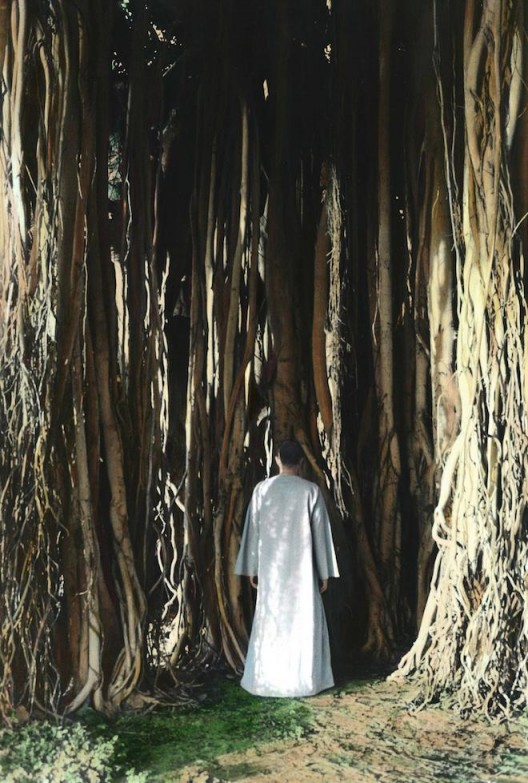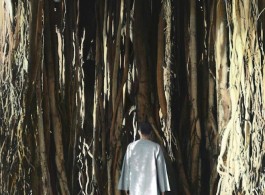Galerie Nathalie Obadia
The Galerie Nathalie Obadia is pleased to present the first exhibition by Youssef Nabil in Brussels. Titled Deep Roots, this exhibition, in the form of a retrospective, covers the artist’s full career from his first colour photographs in 1992 until his most recent and unseen self-portraits.
An impassioned admirer of the seventh art, Youssef Nabil was born in Cairo in 1972 and deeply marked by the aesthetic of the golden years of Egyptian cinema during the 1940s and ’50s. All his work venerates, while also reviving, this “belle époque” of the East, magnified by cinema and its sequins and velvety-eyed stars. This nostalgia-tinted zeal has haunted him since the childhood he spent in the streets of the Egyptian capital, during the period they were lined with posters glorifying his idols.
As the young boy dreamed of his life in Technicolor, he became aware that the actors and actresses that he worshipped were either no longer of this world or ageing. This awareness stimulated the irrepressible desire in him to meet and immortalise those who were still living, an ambition that took material form in the creation of an imaginary reality that continues to run through his work. By awakening the flamboyant ghosts of Egypt’s pre-revolutionary films, Youssef Nabil reflects on the paradoxes of the Middle East today, in which freedoms have dangerously lost ground to religious fundamentalism on all sides.

Youssef Nabil, Untitled, Self-portrait, Hawaii 2013, 2013. Hand colored gelatin silver print, 56,5 x 43,5 cm (22 1/4 x 17 1/8 inch)
Courtesy Youssef Nabil & Galerie Nathalie Obadia Paris/Bruxelles
Nabil took up photography in 1992 as an autodidact. He took his first images in black and white in an attempt to capture the elegance he was so fond of in the cinema of the past. Three years later, in 1995, he employed colour in his photography but did so using the technique employed by the colourists of Technicolor films: by manually painting his black-and-white negatives. He learned this skill directly from those who still made use of it in the portrait studios of Cairo and Alexandria in the early 1990s, just as the use of their art was beginning to wane.
Deep Roots illustrates this early development with Amani on Roof, Cairo (1992) and Girls Playing Cards, Cairo (1993), which recreate – in period costume – melodramatic moments from the golden age of Egyptian cinema. His first photographs paid tribute to oriental femininity, which, such as it was communicated in the West’s Romantic art of the 19th century, was both sensual and borderline dangerous.
Since the 1990s, Youssef Nabil has continued with his portraits of artists and celebrities in the world of cinema. The choice of décor and staging of the scene are always decided as a result of his meetings with the models. For example, for his portrait of Natacha Atlas, an Anglo-Syrian singer, he captured the “oriental” side of her nature in the form of an odalisque typical of Orientalist painting (Natacha Atlas, Cairo, 2000).
This contained, old-fashioned eroticism is seen identically in the images taken from his two films. The first, You Never Left, brings actors Fanny Ardant and Tahar Rahim together in an allegorical elsewhere that operates as a metaphor for the Egypt that has been lost. Previewed in 2010 at the opening of the Mathaf (Arab Museum of Modern Art, Doha, Qatar), and again in 2011 at the Galerie Nathalie Obadia in Paris, the film enjoyed extensive critical success that led to his name being included in a New Wave of Arab artists remodelling the international artistic landscape.
Several photographs from the second film, I Saved My Belly Dancer (2015), which is currently being presented at the Pérez Art Museum in Miami (USA), featuring Salma Hayek as the belly dancer, are included in the Deep Roots exhibition. The choice of the lead character’s occupation is significant at a time when belly dancing – a secular tradition and a symbol of Middle Eastern sensuality – is viewed with disgrace by extremists who battle constantly against the freedom of the body, in particular women’s. Thus, the project I Saved My Belly Dancer is an act of resistance against the pervading obscurantism, as well as being a statement of support for oriental women, even when the models used by Youssef Nabil only become such characters through the use of illusion and make-believe.
.jpg)
Youssef Nabil, Natacha Atlas, Cairo 2000, 2000. Hand colored gelatin silver print, 43,5 x 56,5 cm (17 1/8 x 22 1/4 inch)
Courtesy Youssef Nabil & Galerie Nathalie Obadia Paris/Bruxelles
The exhibition Deep Roots presents no fewer than twelve self-portraits made throughout the artist’s career. Created in Paris, Rome, Naples, Los Angeles, and of course Cairo, his place of birth, the series is like a journal in Nabil’s life. He has said, “I think I will continue this all my life as it is a sort of private diary”.
He is usually seen himself shown from behind, as in this self-portrait taken in front of the Great Pyramid (Self-Portrait with a Pyramid, 2009) and this one seen on the banks of the Nile (Self-Portrait with the Nile, Luxor, 2014). Although these images of sites of Egyptian history are rather in the spirit of postcards, for the nomad artist Youssef Nabil they represent his “Homeland”, which he left in 2003 to pursue his international career in Paris, followed by New York. “Lately, everything going on at home has made me sad, pensive and worried. Perhaps that comes across in my self-portraits”, he wonders. Might it be that by representing himself facing away, he is actually turning his back on the past? Quite the opposite. This organisation of the figure and motif is indicative of the moment of departure and the wrenching feeling experienced when leaving a well-loved place for a long time. This is a feeling that has never left Youssef Nabil, who is nostalgic about both his country and a more carefree and tolerant period than exists today.
This series of self-portraits was exhibited in Hawaii in 2013. It included a photo of the artist posing in a galabeya, an Egyptian garment, by large tropical trees chosen for the beauty of their tentacular trunks (Untitled, Self-Portrait, Hawaii, 2013). With their contact, he allegorically renews contact with his own oriental roots. In permanent exile, the uprooted Nabil continues to regenerate and spread his rhizomes through his journeys, offering proof that, though far from home, it is still possible to find hospitable lands productive to the expression of his ideas.
From his studios in New York and Paris, Youssef Nabil – an emigrant who has become a citizen of the world – has moved beyond his personal experiences by engaging with a universal language that he applies to his photographs and films. Beneath the pastel colours of his coloured images radiates a seriousness that invites deep introspection and questioning of the state of society today.
![]()
Born in 1972, Youssef Nabil lives and works in New York (USA).
Three important monographs have been written about him and his work: Sleep In My Arms (Autograph ABP and Michael Stevenson, 2007), I Won’t Let You Die (Hatje Cantz, 2008) and Youssef Nabil, published by Flammarion in 2013.
Known for his work that combines photography and painting, in 2010 Youssef Nabil presented his first film You Never Left at the opening of the Mathaf (Arab Museum of Modern Art, Doha, Qatar). His second film, I Saved My Belly Dancer, is currently being presented at the Pérez Art Museum in Miami (USA).
Youssef Nabil has had many exhibitions in renowned institutions and biennials in many countries: in the USA, at the Pérez Art Museum (PAMM) in Miami, the Los Angeles County Museum of Art (LACMA), the Studio Museum in Harlem and Aperture Foundation in New York, the Smithsonian National Museum of African Art and Kennedy Center in Washington, D.C., the Savannah College of Art and Design (SCAD) in Savannah, and the North Carolina Museum of Art in Raleigh; in Canada, at the Aga Khan Museum of Art in Toronto ; in France, at the Centre Pompidou, Maison Rouge – Fondation Antoine de Galbert, Arab World Institute, and Maison Européenne de la Photographie in Paris, the Frac Normandie in Sotteville-lès-Rouen, the Friche Belle de Mai in Marseille, and the Rencontres de la Photographie in Arles ; in Belgium, at the Fondation Boghossian and Maison Particulière in Brussels ; in the UK, at the British Museum and Victoria & Albert Museum in London, and the BALTIC Centre for Contemporary Art in Newcastle ; in Germany, at the Museum für Modern Kunst (MMK) in Frankfurt, the Kunstmuseum in Bonn, and the Gemäldegalerie Staatliche Museen in Berlin ; in Spain, at the Museum of Contemporary Art (MACBA) in Barcelona, the Centro Andaluz de Arte Contemporáneo in Seville, and the Instituto d’Art Modern in Valencia ; in Italy, at the Villa Medici in Rome, the Galleria dell’Accademia in Florence, and the 53rd Venice Biennale, Unconditional Love ; in Qatar, at the Mathaf Arab Museum of Modern Art in Doha; in Brazil, at the Galeria Leme in São Paulo ; in Mexico, at the Centro de la Imagen in Mexico City; and in Mali, at the 5èmes Rencontres de la Photographie africaine in Bamako, during which he was awarded the Seydou Keïta Portrait Prize.
Youssef Nabil’s works are included in many outstanding international collections, among which: in the USA, the Los Angeles County Museum of Art (LACMA), the Pérez Art Museum in Miami (PAMM), the Studio Museum in Harlem, New York, and the Savannah College of Art and Design Museum of Art (SCAD) in Savannah ; in France, the Fondation Louis Vuitton, the Collection François Pinault, and the Maison Européenne de la Photographie in Paris ; in Switzerland, the Collection UBS Art in Zürich ; in the UK, the British Museum and the Victoria & Albert Museum in London ; in Angola, the Sindika Dokolo Foundation in Luanda ; in Greece, the Photography Museum in Thessaloniki ; in Qatar, the Mathaf Arab Museum of Modern Art in Doha ; in the United Arab Emirates, the Guggenheim Museum in Abu Dhabi ; in Mexico, the Centro de la Imagen in Mexico City.



